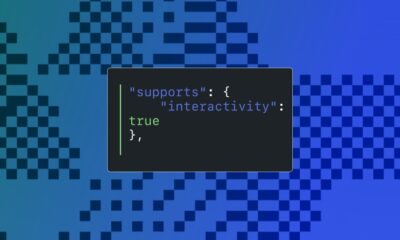MARKETING
Everything You Need To Know About Google Web Stories
Google is not a social media channel per se, but one of its features, Google Web Stories, is similar to the stories format that you’d see on popular sites like Instagram.
It poses a unique opportunity for creators, so read on to learn all about Google Web Stories, what they can do for your business, and how to create them and make an impact.
Table of Contents:
What are Google Web Stories?
Google Web Stories are interactive, video-first pieces of content that creators can use to share information with audiences through tappable pages featuring audio, images, and text. The Web Story format was formerly known as AMP Stories.
Google says that styles that work the best with the format are first-person narratives, evergreen or updating stories, live stories, educational and experiential stories, and quizzes and polls.
Web Stories appear in standard Google Search results and as carousels in Google Discover, and you can also add them to a newsletter and link to them from your social media accounts. The image below shows a Web Story in Google Discover on the left and Google Search on the right.
 Web Stories are also individual pages on your website, so they can be indexed and surfaced in relevant results. You can feature them as individual pieces of content within your website or embed them like podcast episodes or YouTube videos. The video below from Google for Creators goes into more detail.
Web Stories are also individual pages on your website, so they can be indexed and surfaced in relevant results. You can feature them as individual pieces of content within your website or embed them like podcast episodes or YouTube videos. The video below from Google for Creators goes into more detail.
Google Web Stories Format
Web Stories have three parts: a poster, a cover page, and story pages.
The poster is the first thing someone sees in your Story, and Google describes it as the packaging. Your cover page is the first page of the content of your story, and story pages are where you begin to tell your story and narrative with video, text, and your preferred assets.

There is only one poster and cover page per story, but you can have multiple story pages.
Can you monetize Google Web Stories?
You can monetize Google Web Stories with AdSense, Ad Manager, and display ads. You can also include affiliate links as attachments or CTAs.
Google Web Stories Examples
1. INPUT – Ford’s Mustang Mach-E 1400 Prototype

This Web Story begins with what feels like a real-life experience as a car zooms across the screen and speeds across a race track. Ford’s Mustang Mach-E 1400 Prototype is a standout Web Story because of its expert use of video to draw users in. It embodies the video-first elements Google recommends and continues to be interactive throughout the rest of the piece.
2. Nylon – 10 Black-Authored Books To Add To Your Summer Reading List

Nylon’s 10 Black-Authored Books To Add To Your Summer Reading List Story is an excellent example of expertly using attachments and shoppable links to inspire interaction with viewers and make the user experience seamless. Viewers can tap through and read summaries of each book and, when interested, can click a link to be automatically directed to a site where they can purchase the book.
3. Vice – The Burger Sisters of Kenya

The Burger Sisters of Kenya is a Web Story about two sisters who own a famous burger food truck in Kenya. This Story is a great inspiration as it features a first-person narrative that feels like a conversation, high-quality video and visuals, and it minds accessibility with captions and audio transcriptions.
How to Make Google Web Stories
This Google format can bring various benefits to your business, like sharing a unique and engaging brand story with your audience, inspiring engagement with interactive elements, driving traffic to your different channels, and the ability to monetize and generate revenue.
 Let’s go over how to make them.
Let’s go over how to make them.
1. Storyboard your narrative.
The first step is to storyboard and draft a narrative. Google created a storyboard script template to use to draft your Web Story narrative.

2. Choose an editor.
After you’ve created a final draft, pick the editor you’ll use to create your Story. If you have developer skills, you can follow a tutorial from AMP that will guide you through the process of creating a Story with custom functionality.
If you don’t have developer skills, you can use one of the recommended no-coding necessary editors.
If you’re a WordPress user, you can use the Web Stories Plugin.
Google Web Stories Plugin
The Web Stories for WordPress plugin, built by Google, will help you easily create and publish your Web Stories on your WordPress site. The editor includes templates, a drag and drop builder, space for custom branded elements, and you can grab existing assets from your WordPress Media Library.

3. Create your Web Story
Once you’ve chosen your editor, begin building your Web Story.
4. Test your web story before publishing.
The final step is to enable your Web Story on Google, and this requires testing it with various tools.
To embed a Web Story on your WordPress site, you’d use the Web Stories block. If you’ve created your Web Story with any AMP tools, you’ll receive an embed link that you can paste within your site code.
Best Practices for Creating Google Web Stories
Let’s go over some best practices for creating your Web Stories.

1. Champion video-first storytelling.
Google meant for Web Stories to be video-first. It favors video over all else but welcomes audio, images, and animations that help you create a narrative. You can include text, but when you use it, aim for less than 280 characters, or approximately 40 to 70 words per page.
2. Use engaging elements.
Stories are meant to be interactive and engaging for users, so aim to use interactive elements.
The best way to do so is to have multiple story pages so you capture viewer attention and get them excited to tap and learn more. You can also include interactive quizzes and polls, CTAs, and links to different pages to increase viewer interaction with your content sources.
3. Use your brand identity.
Stories show up in SERPs and Google Discover, so you want to include your unique brand elements, so audiences know it’s you.
4. Ensure your stories are AMP valid.
Web Stories run on the AMP framework, so they need to be AMP valid. We recommended various testing tools above, so make sure to use them throughout your process to ensure your Stories can appear on the web.
5. Make your Web Stories accessible.
Although you want to champion visual storytelling, your Web Stories also need to be accessible. Add alt text to your images, transcribe audio, use subtitles and captions, and add metadata to your Stories to ensure everyone can benefit from them.
6. Be mindful of Google’s SEO standards.
As mentioned above, Web Stories are pages on your website. As a result, you want to be mindful of SEO best practices when creating your Web Stories so they can be indexed and ready to appear in SERPs.
Google Web Stories SEO Checklist
The same standard SEO best practices apply to Web Stories. If you already have an SEO strategy for your business, reference it throughout your process. However, there are key Web Story SEO factors to be aware of.
- You want to add metadata to all elements of your Web Story, as it will speak directly to search engines and discover features that want to learn what’s in them. You can optimize for this by following along with AMP metadata guidelines.
- Your Web Stories are pages on your website, so you want them to be self-canonical. Each of your Stories should have a link rel=“canonical” to itself.
- Story titles should be shorter than 90 characters.
- Add Web Stories to your site map and don’t include noindex attributes. You can check if you’ve been indexed using the Index Coverage Report.
- All Web Stories need AMP structured data.
- All Images need alt text to improve discoverability, and video needs subtitles.
Over To You
The story format provides similar benefits on Google as it would on your other channels, so it’s worth considering. If you’re ready to use the feature, leverage the instructions on this list to begin creating a unique, interactive piece of content that is sure to delight your audience.
MARKETING
Tinuiti Marketing Analytics Recognized by Forrester

Rapid Media Mix Modeling and Proprietary Tech Transform Brand Performance
Tinuiti, the largest independent full-funnel performance marketing agency, has been included in a recent Forrester Research report titled, “The Marketing Analytics Landscape, Q2 2024.” This report comprehensively overviews marketing analytics markets, use cases, and capabilities. B2C marketing leaders can use this research by Principal Analyst Tina Moffett to understand the intersection of marketing analytics capabilities and use cases to determine the vendor or service provider best positioned for their analytics and insights needs. Moffett describes the top marketing analytics markets as advertising agencies, marketing dashboards and business intelligence tools, marketing measurement and optimization platforms and service providers, and media analytics tools.
As an advertising agency, we believe Tinuiti is uniquely positioned to manage advertising campaigns for brands including buying, targeting, and measurement. Our proprietary measurement technology, Bliss Point by Tinuiti, allows us to measure the optimal level of investment to maximize impact and efficiency. According to the Forrester report, “only 30% of B2C marketing decision-makers say their organization uses marketing or media mix modeling (MMM),” so having a partner that knows, embraces, and utilizes MMM is important. As Tina astutely explains, data-driven agencies have amplified their marketing analytics competencies with data science expertise; and proprietary tools; and tailored their marketing analytics techniques based on industry, business, and data challenges.
Our Rapid Media Mix Modeling sets a new standard in the market with its exceptional speed, precision, and transparency. Our patented tech includes Rapid Media Mix Modeling, Always-on Incrementality, Brand Equity, Creative Insights, and Forecasting – it will get you to your Marketing Bliss Point in each channel, across your entire media mix, and your overall brand performance.
As a marketing leader you may ask yourself:
- How much of our marketing budget should we allocate to driving store traffic versus e-commerce traffic?
- How should we allocate our budget by channel to generate the most traffic and revenue possible?
- How many customers did we acquire in a specific region with our media spend?
- What is the impact of seasonality on our media mix?
- How should we adjust our budget accordingly?
- What is the optimal marketing channel mix to maximize brand awareness?
These are just a few of the questions that Bliss Point by Tinuiti can help you answer.
Learn more about our customer-obsessed, product-enabled, and fully integrated approach and how we’ve helped fuel full-funnel outcomes for the world’s most digital-forward brands like Poppi & Toms.
The Landscape report is available online to Forrester customers or for purchase here.
MARKETING
Ecommerce evolution: Blurring the lines between B2B and B2C

Understanding convergence
B2B and B2C ecommerce are two distinct models of online selling. B2B ecommerce is between businesses, such as wholesalers, distributors, and manufacturers. B2C ecommerce refers to transactions between businesses like retailers and consumer brands, directly to individual shoppers.
However, in recent years, the boundaries between these two models have started to fade. This is known as the convergence between B2B and B2C ecommerce and how they are becoming more similar and integrated.
Source: White Paper: The evolution of the B2B Consumer Buyer (ClientPoint, Jan 2024)
What’s driving this change?
Ever increasing customer expectations
Customers today expect the same level of convenience, speed, and personalization in their B2B transactions as they do in their B2C interactions. B2B buyers are increasingly influenced by their B2C experiences. They want research, compare, and purchase products online, seamlessly transitioning between devices and channels. They also prefer to research and purchase online, using multiple devices and channels.
Forrester, 68% of buyers prefer to research on their own, online . Customers today expect the same level of convenience, speed, and personalization in their B2B transactions as they do in their B2C interactions. B2B buyers are increasingly influenced by their B2C experiences. They want research, compare, and purchase products online, seamlessly transitioning between devices and channels. They also prefer to research and purchase online, using multiple devices and channels
Technology and omnichannel strategies
Technology enables B2B and B2C ecommerce platforms to offer more features and functionalities, such as mobile optimization, chatbots, AI, and augmented reality. Omnichannel strategies allow B2B and B2C ecommerce businesses to provide a seamless and consistent customer experience across different touchpoints, such as websites, social media, email, and physical stores.
However, with every great leap forward comes its own set of challenges. The convergence of B2B and B2C markets means increased competition. Businesses now not only have to compete with their traditional rivals, but also with new entrants and disruptors from different sectors. For example, Amazon Business, a B2B ecommerce platform, has become a major threat to many B2B ecommerce businesses, as it offers a wide range of products, low prices, and fast delivery
“Amazon Business has proven that B2B ecommerce can leverage popular B2C-like functionality” argues Joe Albrecht, CEO / Managing Partner, Xngage. . With features like Subscribe-and-Save (auto-replenishment), one-click buying, and curated assortments by job role or work location, they make it easy for B2B buyers to go to their website and never leave. Plus, with exceptional customer service and promotional incentives like Amazon Business Prime Days, they have created a reinforcing loyalty loop.
And yet, according to Barron’s, Amazon Business is only expected to capture 1.5% of the $5.7 Trillion addressable business market by 2025. If other B2B companies can truly become digital-first organizations, they can compete and win in this fragmented space, too.”
If other B2B companies can truly become digital-first organizations, they can also compete and win in this fragmented space
Joe AlbrechtCEO/Managing Partner, XNGAGE
Increasing complexity
Another challenge is the increased complexity and cost of managing a converging ecommerce business. Businesses have to deal with different customer segments, requirements, and expectations, which may require different strategies, processes, and systems. For instance, B2B ecommerce businesses may have to handle more complex transactions, such as bulk orders, contract negotiations, and invoicing, while B2C ecommerce businesses may have to handle more customer service, returns, and loyalty programs. Moreover, B2B and B2C ecommerce businesses must invest in technology and infrastructure to support their convergence efforts, which may increase their operational and maintenance costs.
How to win
Here are a few ways companies can get ahead of the game:
Adopt B2C-like features in B2B platforms
User-friendly design, easy navigation, product reviews, personalization, recommendations, and ratings can help B2B ecommerce businesses to attract and retain more customers, as well as to increase their conversion and retention rates.
According to McKinsey, ecommerce businesses that offer B2C-like features like personalization can increase their revenues by 15% and reduce their costs by 20%. You can do this through personalization of your website with tools like Product Recommendations that help suggest related products to increase sales.
Focus on personalization and customer experience
B2B and B2C ecommerce businesses need to understand their customers’ needs, preferences, and behaviors, and tailor their offerings and interactions accordingly. Personalization and customer experience can help B2B and B2C ecommerce businesses to increase customer satisfaction, loyalty, and advocacy, as well as to improve their brand reputation and competitive advantage. According to a Salesforce report, 88% of customers say that the experience a company provides is as important as its products or services.
Market based on customer insights
Data and analytics can help B2B and B2C ecommerce businesses to gain insights into their customers, markets, competitors, and performance, and to optimize their strategies and operations accordingly. Data and analytics can also help B2B and B2C ecommerce businesses to identify new opportunities, trends, and innovations, and to anticipate and respond to customer needs and expectations. According to McKinsey, data-driven organizations are 23 times more likely to acquire customers, six times more likely to retain customers, and 19 times more likely to be profitable.
What’s next?
The convergence of B2B and B2C ecommerce is not a temporary phenomenon, but a long-term trend that will continue to shape the future of ecommerce. According to Statista, the global B2B ecommerce market is expected to reach $20.9 trillion by 2027, surpassing the B2C ecommerce market, which is expected to reach $10.5 trillion by 2027. Moreover, the report predicts that the convergence of B2B and B2C ecommerce will create new business models, such as B2B2C, B2A (business to anyone), and C2B (consumer to business).
Therefore, B2B and B2C ecommerce businesses need to prepare for the converging ecommerce landscape and take advantage of the opportunities and challenges it presents. Here are some recommendations for B2B and B2C ecommerce businesses to navigate the converging landscape:
- Conduct a thorough analysis of your customers, competitors, and market, and identify the gaps and opportunities for convergence.
- Develop a clear vision and strategy for convergence, and align your goals, objectives, and metrics with it.
- Invest in technology and infrastructure that can support your convergence efforts, such as cloud, mobile, AI, and omnichannel platforms.
- Implement B2C-like features in your B2B platforms, and vice versa, to enhance your customer experience and satisfaction.
- Personalize your offerings and interactions with your customers, and provide them with relevant and valuable content and solutions.
- Leverage data and analytics to optimize your performance and decision making, and to innovate and differentiate your business.
- Collaborate and partner with other B2B and B2C ecommerce businesses, as well as with other stakeholders, such as suppliers, distributors, and customers, to create value and synergy.
- Monitor and evaluate your convergence efforts, and adapt and improve them as needed.
By following these recommendations, B2B and B2C ecommerce businesses can bridge the gap between their models and create a more integrated and seamless ecommerce experience for their customers and themselves.
MARKETING
Streamlining Processes for Increased Efficiency and Results

How can businesses succeed nowadays when technology rules? With competition getting tougher and customers changing their preferences often, it’s a challenge. But using marketing automation can help make things easier and get better results. And in the future, it’s going to be even more important for all kinds of businesses.
So, let’s discuss how businesses can leverage marketing automation to stay ahead and thrive.
Benefits of automation marketing automation to boost your efforts
First, let’s explore the benefits of marketing automation to supercharge your efforts:
Marketing automation simplifies repetitive tasks, saving time and effort.
With automated workflows, processes become more efficient, leading to better productivity. For instance, automation not only streamlines tasks like email campaigns but also optimizes website speed, ensuring a seamless user experience. A faster website not only enhances customer satisfaction but also positively impacts search engine rankings, driving more organic traffic and ultimately boosting conversions.
Automation allows for precise targeting, reaching the right audience with personalized messages.
With automated workflows, processes become more efficient, leading to better productivity. A great example of automated workflow is Pipedrive & WhatsApp Integration in which an automated welcome message pops up on their WhatsApp
within seconds once a potential customer expresses interest in your business.
Increases ROI
By optimizing campaigns and reducing manual labor, automation can significantly improve return on investment.
Leveraging automation enables businesses to scale their marketing efforts effectively, driving growth and success. Additionally, incorporating lead scoring into automated marketing processes can streamline the identification of high-potential prospects, further optimizing resource allocation and maximizing conversion rates.
Harnessing the power of marketing automation can revolutionize your marketing strategy, leading to increased efficiency, higher returns, and sustainable growth in today’s competitive market. So, why wait? Start automating your marketing efforts today and propel your business to new heights, moreover if you have just learned ways on how to create an online business
How marketing automation can simplify operations and increase efficiency
Understanding the Change
Marketing automation has evolved significantly over time, from basic email marketing campaigns to sophisticated platforms that can manage entire marketing strategies. This progress has been fueled by advances in technology, particularly artificial intelligence (AI) and machine learning, making automation smarter and more adaptable.
One of the main reasons for this shift is the vast amount of data available to marketers today. From understanding customer demographics to analyzing behavior, the sheer volume of data is staggering. Marketing automation platforms use this data to create highly personalized and targeted campaigns, allowing businesses to connect with their audience on a deeper level.
The Emergence of AI-Powered Automation
In the future, AI-powered automation will play an even bigger role in marketing strategies. AI algorithms can analyze huge amounts of data in real-time, helping marketers identify trends, predict consumer behavior, and optimize campaigns as they go. This agility and responsiveness are crucial in today’s fast-moving digital world, where opportunities come and go in the blink of an eye. For example, we’re witnessing the rise of AI-based tools from AI website builders, to AI logo generators and even more, showing that we’re competing with time and efficiency.
Combining AI-powered automation with WordPress management services streamlines marketing efforts, enabling quick adaptation to changing trends and efficient management of online presence.
Moreover, AI can take care of routine tasks like content creation, scheduling, and testing, giving marketers more time to focus on strategic activities. By automating these repetitive tasks, businesses can work more efficiently, leading to better outcomes. AI can create social media ads tailored to specific demographics and preferences, ensuring that the content resonates with the target audience. With the help of an AI ad maker tool, businesses can efficiently produce high-quality advertisements that drive engagement and conversions across various social media platforms.
Personalization on a Large Scale
Personalization has always been important in marketing, and automation is making it possible on a larger scale. By using AI and machine learning, marketers can create tailored experiences for each customer based on their preferences, behaviors, and past interactions with the brand.
This level of personalization not only boosts customer satisfaction but also increases engagement and loyalty. When consumers feel understood and valued, they are more likely to become loyal customers and brand advocates. As automation technology continues to evolve, we can expect personalization to become even more advanced, enabling businesses to forge deeper connections with their audience. As your company has tiny homes for sale California, personalized experiences will ensure each customer finds their perfect fit, fostering lasting connections.
Integration Across Channels
Another trend shaping the future of marketing automation is the integration of multiple channels into a cohesive strategy. Today’s consumers interact with brands across various touchpoints, from social media and email to websites and mobile apps. Marketing automation platforms that can seamlessly integrate these channels and deliver consistent messaging will have a competitive edge. When creating a comparison website it’s important to ensure that the platform effectively aggregates data from diverse sources and presents it in a user-friendly manner, empowering consumers to make informed decisions.
Omni-channel integration not only betters the customer experience but also provides marketers with a comprehensive view of the customer journey. By tracking interactions across channels, businesses can gain valuable insights into how consumers engage with their brand, allowing them to refine their marketing strategies for maximum impact. Lastly, integrating SEO services into omni-channel strategies boosts visibility and helps businesses better understand and engage with their customers across different platforms.
The Human Element
While automation offers many benefits, it’s crucial not to overlook the human aspect of marketing. Despite advances in AI and machine learning, there are still elements of marketing that require human creativity, empathy, and strategic thinking.
Successful marketing automation strikes a balance between technology and human expertise. By using automation to handle routine tasks and data analysis, marketers can focus on what they do best – storytelling, building relationships, and driving innovation.
Conclusion
The future of marketing automation looks promising, offering improved efficiency and results for businesses of all sizes.
As AI continues to advance and consumer expectations change, automation will play an increasingly vital role in keeping businesses competitive.
By embracing automation technologies, marketers can simplify processes, deliver more personalized experiences, and ultimately, achieve their business goals more effectively than ever before.
-

 SEARCHENGINES7 days ago
SEARCHENGINES7 days agoGoogle Core Update Volatility, Helpful Content Update Gone, Dangerous Google Search Results & Google Ads Confusion
-

 SEO7 days ago
SEO7 days ago10 Paid Search & PPC Planning Best Practices
-

 MARKETING5 days ago
MARKETING5 days ago5 Psychological Tactics to Write Better Emails
-

 SEARCHENGINES6 days ago
SEARCHENGINES6 days agoWeekend Google Core Ranking Volatility
-

 MARKETING6 days ago
MARKETING6 days agoThe power of program management in martech
-

 SEO6 days ago
SEO6 days agoWordPress Releases A Performance Plugin For “Near-Instant Load Times”
-

 PPC5 days ago
PPC5 days ago20 Neuromarketing Techniques & Triggers for Better-Converting Copy
-
SEARCHENGINES4 days ago
Daily Search Forum Recap: April 15, 2024

















You must be logged in to post a comment Login